American physicians are in the dark ages in treating gender conflicts in America’s youth. There are several reasons for this but one of the major reasons is that gender medicine has been mixed up with gender activism. Since there is little scientific evidence for gender dysphoria, transgenderism has become a mental health problem. And with little evidence to scientifically prove their point, activists are free to impose their own beliefs through bullying and threats of ruined careers unless other providers fall in line.
But in Europe, there is a healthy, ongoing debate about gender dysphoria — who has it and most especially, how far should gender physicians go in treating young people.
In Finland, Dr. Riittakerttu Kaltiala is the chief psychiatrist at one of its two government-approved pediatric gender clinics. She has presided over gender-transitioning youth since 2011. In other words, she’s hardly a “transphobe” or uninformed on the subject of gender-transitioning youth.
Finland follows what’s known as the “Dutch Protocols,” which allow for puberty blockers in very restricted circumstances. But by 2015, Dr. Kaltiala and other gender specialists noticed that “most of their patients did not match the profile of those treated in the Netherlands and did not meet the Dutch protocol’s relatively strict eligibility requirements for drug treatments,” according to The Tablet.
Due to the extremely high rate at which children with gender issues come to terms with their bodies (or “desist”) by adulthood, the Dutch protocol requires patients to have gender dysphoria that begins before puberty and intensifies in adolescence. It also requires them to have no serious co-occurring mental health problems, to undergo at least six months of psychotherapy, and to have the support of their family for hormonal treatments.
One can immediately see the difference between American physician-activists and their European counterparts. The recent expose by an employee working for the St. Louis University Hospital gender clinic revealed the presence of mental illness in most patients and no requirement for psychotherapy.
As I said, “the dark ages” indeed.
Within a few years of their country adopting the Dutch protocol in 2011, however, Finnish researchers noticed a sharp rise in the number of patients referred for services. Most of these patients were teenage girls with no history of dysphoria in childhood, and some 75% had a history of severe psychopathology prior to the emergence of their gender-related distress. During this same time period, the U.K.’s largest pediatric gender clinic, at the Tavistock Centre, witnessed a 3,360% surge in patient referrals between 2009 and 2018. Most of the new patients were females—whose representation in the clinic rose 4,400% during this time frame—with a history of serious psychological problems and no gender dysphoria prior to adolescence.
Is it a coincidence that American clinics report seeing a similar astronomical rise in teen girls complaining of dysphoria? It’s called “Rapid Onset Gender Dysphoria,” which is well-accepted in Europe but still controversial in the United States.
In their 2017 article “Gender Dysphoria Is Not One Thing” Blanchard and Bailey agree on a third main type of gender dysphoria, that of Rapid Onset Gender Dysphoria. This manifests in teenage girls around puberty who had shown no signs of being gender non-conforming prior to puberty. This was the phenomenon described by Lisa Littman in her research which was published in 2018, Lisa noted a social contagion element amongst these girls and a connection with use of social media sites such as Tumblr.
Gender dysphoria as a teen girl social contagion? Perish the thought. Surely there must be another cause of this massive jump in teen girls claiming to be boys.
That’s why Finland, Sweden, and the UK agreed to conduct a “systematic review of the evidence” for the benefits and risks of hormonal interventions.
Systematic reviews represent the highest level of evidence analysis in evidence based medicine. The three European countries that did these reviews independently came to the same conclusion: Due to their severe methodological limitations, studies cited in support of hormonal interventions for adolescents are of “very low” certainty. For health authorities in these countries, this meant that the studies were too unreliable to justify the risks and uncertainties of “gender affirming care.” Sweden, Finland, and England have since placed severe restrictions on access to hormones. Although these countries now allow hormones in a very carefully selected cohort of patients who fulfill the criteria of the Dutch protocol, they do so against the findings of their own systematic reviews. That is because the systematic reviews found the Dutch study, on which the Dutch protocol is based, also provides “very low” certainty evidence. Finland’s Council on Choices in Healthcare recognizes medical transition for minors as “an experimental practice.”
Kaltiala recently testified before a Florida panel on treating transgender youth. The Tablet reports she told the panel that “Evidence from a combined 12 studies to date demonstrates that when children with cross-gender or gender variant behavior are left to develop naturally, the vast majority—’four out of five,’ according to Kaltiala—come to terms with their bodies and learn to accept their sex. When they are socially transitioned, virtually none do.”
Related: How Will the Trans Cult React to This Proposed Bill in Florida?
Trans-rights campaigners are seeking to have the need for a medical diagnosis of gender dysphoria removed and for people to be able to self-identify their legal sex at any age. I find it interesting that at a moment in time when Europeans are pulling back and slowing the drive to give children gender-affirming care, the American gender care community wants to run full speed ahead into a future catastrophe.
Why? There has to be a political motivation for people to ignore all evidence to the contrary to push an agenda on America’s most vulnerable children.










Join the conversation as a VIP Member